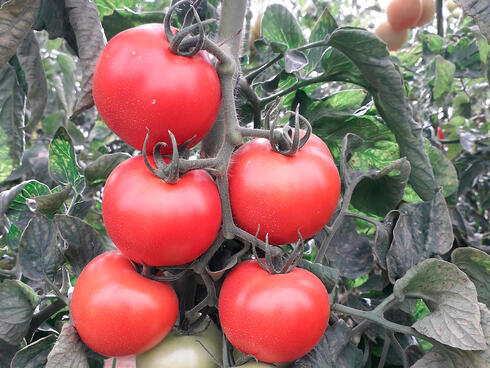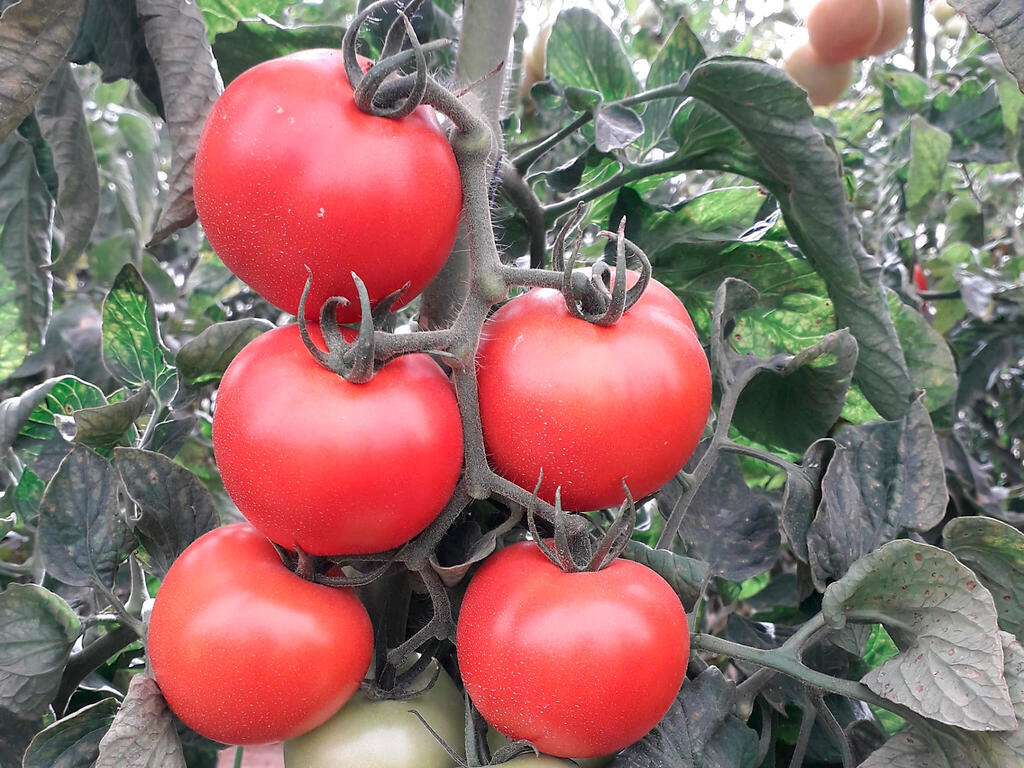
Israeli researchers develop tomatoes resilient to viruses and heat to tackle crop threats
Innovative approaches are enhancing tomato durability against destructive diseases and climate change.
The tomato is considered a particularly popular fruit in Israel. It features in all meals, and it's hard to imagine our dining table without it. However, over the past month, many Israelis have struggled to find tomatoes in their local supermarkets. When tomatoes do appear on the shelves, the prices are exorbitant and the quality is low. The suspension of imports from Turkey and supplies from Jordan, due to suspected cholera, has led to a 40% shortage of tomatoes in the market. Local issues also contribute: reliance on increasing imports has reduced local production, which is already declining each year due to climate change. Adding to the problem is a virulent virus that can easily wipe out entire greenhouses.
Each year, around 189 million tons of tomatoes are harvested globally, with the majority grown in California, China, and Italy. However, the climate crisis is causing disruptions on supermarket shelves, and these are expected to continue. For instance, California reported a tomato crop of 9.5 million tons in 2022, compared to the usual 12 million tons, due to prolonged high temperatures and persistent drought.
Ketchup manufacturers are also under pressure
A recent study published in Nature predicts that by 2050, rising temperatures will lead to a permanent decrease of about 6% in tomato crops in Italy and California. Between 2050 and 2100, tomato yields could be halved under a worsening but plausible scenario. Consumers are already feeling the impact on their wallets. Researchers from the Potsdam Institute for Climate Impact Research and the European Central Bank found that by 2035, climate change could increase food prices by around 1% to 3% annually, primarily due to agricultural produce's inability to adapt to heat.
For example, last year, supermarkets in Great Britain, which rely on imports, faced a tomato shortage due to an extreme heat wave affecting growers in Spain and Italy. In Spain's Extremadura region, high temperatures and heavy rains in May and June, followed by heat waves in July, led to a 10% drop in production. In Morocco, an unexpected spring frost destroyed new fruit, causing the price of a kilogram of tomatoes to rise from about 5 Moroccan dirhams (half a dollar) to 12 dirhams (1.2 dollars). The Moroccan government then imposed a partial export ban, and farmers reported abandoning tomato cultivation due to high costs. Today, prices have climbed to about 18 dirhams.
Tomato cultivation in Israel has also been affected. The Ministry of Agriculture explains that local production has declined in recent years due to climate changes, viruses damaging crops, and policies favoring imports. In the past two years, local production hit a low of 119,000 tons in 2022 and only 114,000 tons in 2023. The shortage of tomatoes has pushed prices to NIS 30 per kg, with further increases expected until November. Efforts by the Ministry of Agriculture to encourage summer tomato planting have been ineffective: intense heat damages crops and reduces profitability, compounded by a virus that devastates large yields.
Tomatoes are particularly sensitive to temperature changes, and hot days and nights impair the fertilization process crucial for fruit development. The dramatic rise in the number of hot nights annually in Israel, especially in the Western Negev, the main growing area for tomatoes, has led to decreased yields. The Ministry of Agriculture estimates that the areas where tomatoes can be safely grown in Israel will be reduced as a result.
"In Israel, 18,000 tons of tomatoes of all kinds are consumed per month. Local production covers 10,000 tons, with an additional 8,000 tons imported," explains Dr. Michal Levy, the chief scientist at the Ministry of Agriculture. "The main problem begins in August: the nights are too hot, leading to decreased harvests. This continues until December. We are witnessing an intensification of this trend, especially over the last five years. Winter is shortening and summer is lengthening. The Tekuma region, the main tomato-growing area, faces a complex situation due to the climate crisis and current geopolitical challenges."
Companies searching for solutions
In response, companies are searching for solutions. For instance, ketchup manufacturer Heinz, which relies on California tomatoes, has doubled its investment in the last five years in research to identify tomato varieties that can withstand high temperatures. The Ministry of Agriculture and the Tekuma Directorate have announced a NIS 15 million investment over five years to research methods to increase tomato production and quality in Israel while addressing climate change and pests.
Sometimes, solutions are closer than they seem. The Volcani Institute may be poised to lead the way. Prof. Moshe Lapidot (Director of the Institute of Plant Sciences) and Dr. Michal Lieberman-Lazarovich (Researcher at the Institute of Plant Sciences) are working on research to help tomatoes better withstand severe heat and develop resistance to ToBRFV, a virus causing brown spots on fruit and devastating to growers.
"Each species has an optimal temperature range for optimal fruit production," explains Lieberman-Lazarovich. "Extreme temperatures impair this ability, resulting in smaller fruit yields. However, this is not a predetermined fate but a situation developed over years due to industrialized agriculture and consumer preferences. The fruits and vegetables we eat today have been selected for traits that make them thrive in controlled environments, but they struggle with increasing ambient temperatures."
Lieberman-Lazarovich's research focuses on identifying genes from wild tomato species that offer heat resistance and integrating them into modern tomatoes. "We have identified genomic segments from wild species that confer heat resistance," Lieberman-Lazarovich explains. "Once we pinpoint the genes responsible, we can develop molecular markers and integrate these traits into the varieties used by farmers. This process may take about five years."
Resistance to ToBRFV Virus
The damage caused by high temperatures to tomatoes is significant, but recent years have seen even more severe damage from the ToBRFV virus, which can destroy entire fields rapidly. "This new virus began spreading here in 2014," says Prof. Lapidot, who studies plant viruses and defense mechanisms.
The virus thrives in extreme heat conditions, continuing to spread even at temperatures up to 60 degrees Celsius, while tomatoes die long before that. "With a combination of luck and hard work, we have developed a tomato resistant to this virus," says Lapidot. "We have identified a gene that halts the virus's spread. We are among the first in the world to have a resistant cultured tomato. Although its taste may not be outstanding, it can be used, and through traditional breeding methods, this resistance can be incorporated into high-quality varieties."
Lapidot believes this solution could significantly impact Israel's fields. "The resistant tomatoes we have today show no symptoms of the virus, resulting in minimal crop devaluation. Introducing such resistant varieties could potentially increase the tomato crop in Israel by 20% immediately."
As for the timeline, companies working on virus-resistant tomatoes are close to commercialization, and Lapidot's research is about a year away from market availability. Lieberman-Lazarovich's research on heat resistance will mature in about five years.
Soon, Prof. Lapidot and Dr. Lieberman-Lazarovich will collaborate to combine heat and virus resistance in one tomato. "If the tomato plant suffers from heat, it becomes more vulnerable to virus attacks," summarizes Lieberman-Lazarovich. "Thus, it's crucial to address both issues simultaneously."
Volcani's research is progressing, but to expedite field implementation, additional funding is needed. While the Ministry of Agriculture has financed research identifying one genetic line, Lieberman-Lazarovich’s second research is currently paused due to funding challenges. To advance research and collaborate with commercial companies, additional funding and connections to seed companies are required. This gap could potentially be bridged by the Ministry of Agriculture, similar to procedures used by the Ministry of Economy. A few hundred thousand to two million shekels could advance the research and foster collaboration with commercial entities.
"In urgent issues, action must be taken on multiple levels simultaneously," explains Moshe. "While technical solutions are important, genetic improvements offer long-term benefits. A heat-resistant tomato would remain viable even if greenhouse conditions fail. In Taiwan, where there is 100% humidity, the tomato endures because it doesn’t dry out. In Israel, at 30 degrees Celsius, tomatoes spoil quickly. Technical solutions have their place, but genetic integration provides a lasting solution that can be refined over time. Connecting these elements is essential."















